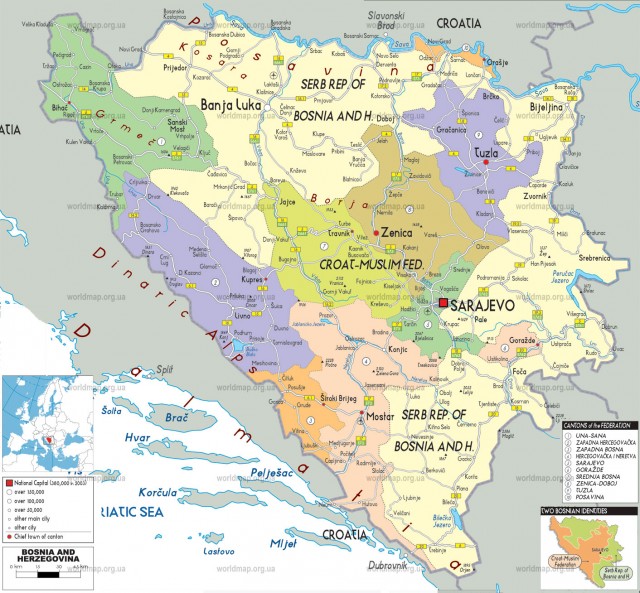Bosnia and Herzegovina
Area 19,940 square mi (51,129 square km)
Population 3.825 million 2014
Capital Sarajevo
Highest Point Maglic 7,826 ft (2,386 m)
Lowest Point 0 m
GDP $18.34 billion 2014
Primary Natural Resources coal, iron, bauxite, zinc, hydropower.
BOSNIA AND HERZEGOVINA was one of the component states of the former federation of Yugoslavia until it declared its independence in March 1992. Its ethnic and religious makeup had become so intertwined under the forced egalitarianism of Josip Tito that divisions and tensions between the country's three major groups—Bosnians, Serbs, and Croats—immediately turned to violence, as each nationality sought to carve out a portion of the country's territory for themselves.
The ensuing conflict caused the deaths of somewhere between 60,000 and 200,000 people and displaced about half the population. Since the peace agreements made in Dayton, Ohio, in December 1995, the country has been partitioned into two federated units, the Federation of Bosnia and Herzegovina and the Republika Srpska (Bosnian Serb Republic). Foreign troops sent in by the NORTH ATLANTIC TREATY ORGANIZATION (NATO) and by RUSSIA keep an uneasy balance, while the country's overall administrative affairs are overseen by a EUROPEAN UNION high commissioner.

Bosnia and Herzegovina occupies a mountainous central zone of the Balkan Peninsula, surrounded on all sides by other former members of Yugoslavia: CROATIA to the north and west, and SERBIA AND ONTENEGRO to the west and south. The country has a tiny outlet to the ADRIATIC SEA, 18 mi or 29 km, wedged between portions of the long Croatian (Dalmatian) coast.
Although some of its rivers flow westward into the Adriatic, notably the Neretva, most Bosnian rivers flow east and north from the watershed of the Dinaric Alps into the Danube basin. These include the Sava, which forms the northern border with Croatia, its tributary the Drina, which forms part of the eastern border with Serbia, and other tributaries of the Sava, the Vrbas, and the Bosna, which gives the country its name. The other half of the country's name, Herzegovina, comes from an ancient feudal division of the region, this part being held by a duke (herzeg is a Slavic corruption of the German word for “duke,” herzog).
Bosnia is much larger than Herzegovina, and although the population is mostly the same, the landscape is different. Herzegovina tends to be drier, rockier, with a Mediterranean climate, versus the more continental climate of the Bosnian interior. Sarajevo, the capital, is roughly in the center of the country, on the Bosna River. Other cities include Banja Luka, Tuzla, Bihac, and Mostar, the capital of Herzegovina. The only area of relative flatness are the plains along the Sava river valley in the far north.
OTTOMAN EMPIRE
Ever since it was settled by Slavic tribes in the 7th century, the region has been dominated and contested by its more powerful neighbors, the Hungarians, the Croats, and the Serbs, with the exception of an independent Bosnian kingdom in the 14th and 15th centuries. The entire Balkan peninsula was incorporated into the empire of the Ottoman Turks dating from the 15th century, but unlike many of its neighbors, a large number of the Bosnian Slavs converted to ISLAM, for reasons ranging from genuine religious conviction to tax breaks and political advancement.
Today's Bosnians are descendants of these people, and differ from their Croat and Serb conationalists mostly in terms of religious affiliation, despite the fact that most Bosnians consider themselves only minimally religious. The Serb and Croat languages are nearly the same, but Serbians use the alphabet of their Orthodox faith, while Croat Catholics use the Latin alphabet. Even after the Dayton Agreement of 1995, the populations have continued to separate along ethnic lines, whereas twenty years ago, ethnic intermarriages were more common than not, almost one in three. The Federation of Bosnia and Herzegovina, primarily populated by Croats and Bosnians, and the Republika Srpska, populated by ethnic Serbs, are both oddly shaped—the latter (with roughly 50 percent of the land) wraps around the former—and include several ENCLAVES within each other, such as the internationally supervised district Brcko.
The wars of the 1990s and subsequent mass emigration has destroyed most of Bosnia's economy and left nearly 45 percent of the population unemployed. Even before the breakup of Yugoslavia and ethnic strife, Bosnia and Herzegovina was (along with Macedonia) the poorest region of the federation. Its economy had been focused not on food production, but chiefly on machinery and military supplies for the rest of Yugoslavia. Bosnia has a good supply of natural resources, including coal, iron, copper, and timber, which could form the core of a revived national economy.